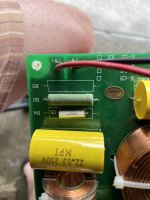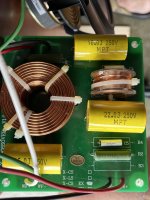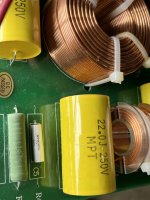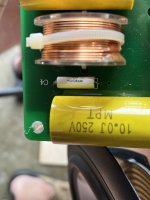Howdy,
First time posting, new dude to the site. Holy Cow, there is a lot here!!
Right now I am into upgrading older speakers for personal use. I have completed a couple CSS kits and Gr-Research kits, which have been pretty successful. Moving into more specifics and trying to get to the next level of "Rookie", the "knowing just enough to mess things up" phase.
I am upgrading a pair of AV123 MTMs, the later version with the upgraded tweeter. The first item on my list is capacitors on the crossover. Because the values are a little out of my league, is there a site or information that helps with cap upgrades.
Danny at GR-R does have kit, kind of wanted to learn a little more this time and see if I can figure out something better or different. The existing caps are:
mpt 22.0j 250v
mpt 15.0j 250v
mpt 10.0j 250v
I do have some caps from an upgrade that never happened:
I will scanning the site for the next few days to see what rabbit hole I should go down, probably just increase the confusion.
Thanks for letting me hang out,
Craig
First time posting, new dude to the site. Holy Cow, there is a lot here!!
Right now I am into upgrading older speakers for personal use. I have completed a couple CSS kits and Gr-Research kits, which have been pretty successful. Moving into more specifics and trying to get to the next level of "Rookie", the "knowing just enough to mess things up" phase.
I am upgrading a pair of AV123 MTMs, the later version with the upgraded tweeter. The first item on my list is capacitors on the crossover. Because the values are a little out of my league, is there a site or information that helps with cap upgrades.
Danny at GR-R does have kit, kind of wanted to learn a little more this time and see if I can figure out something better or different. The existing caps are:
mpt 22.0j 250v
mpt 15.0j 250v
mpt 10.0j 250v
I do have some caps from an upgrade that never happened:
Jantzen Audio 47uF 400V
Jantzen Audio 15uF 400V Crosscap
Jantzen Audio 8.2uF 800V Z-Superior Cap
I will scanning the site for the next few days to see what rabbit hole I should go down, probably just increase the confusion.
Thanks for letting me hang out,
Craig
Cap upgrades do become very expensive especially with film types. Suggest you test out the tweeter circuit first.
The other item to never over look are the resistors, look for better wire wound types
The other item to never over look are the resistors, look for better wire wound types
J means ±5 % tolerance. I'm thinking 22.0 is 22.0 µF.
Your 15 µF will plug directly into the 15.0 µF, but unless you're willing to deviate from the original values, you'll have to get some 22 µF and 10 µF.
Tom
Your 15 µF will plug directly into the 15.0 µF, but unless you're willing to deviate from the original values, you'll have to get some 22 µF and 10 µF.
Tom
So, if I follow - I can pull the crossovers out, buy new caps and resistors that match existing(+/- 5%), using Sonicaps or Jantzen, would work? Are there other capacitor manufacture's that compare, Jantzen and Sonicaps are everywhere?
For me right now, this is a project to understand a little more about the impact of caps, getting better with my soldering, and follow the existing schematic. I know its basic but it helps me understand it better.
Because, a friend gave me the speakers, I am comfortable spending some money to learn more about the impact on different products.
One of the other feeds mentions better wire - is there a type/size/manufacture of wire I should look for?
Thank you all for the follow up,
Craig
For me right now, this is a project to understand a little more about the impact of caps, getting better with my soldering, and follow the existing schematic. I know its basic but it helps me understand it better.
Because, a friend gave me the speakers, I am comfortable spending some money to learn more about the impact on different products.
One of the other feeds mentions better wire - is there a type/size/manufacture of wire I should look for?
Thank you all for the follow up,
Craig
For this project, I would avoid investing a lot of money in replacement parts for these speakers.
Can you post photos of the crossover, and a schematic if possible?
Can you post photos of the crossover, and a schematic if possible?
The capacitance needs to be the same if you want the same crossover frequency response. So you need to replace a 22 µF ±5 % capacitor with another 22 µF capacitor. Ideally, it should have the same (or better) tolerance, so ±5 % or better.
The voltage rating is a function of the dielectric in the capacitor. There is no harm in using a capacitor rated for a higher voltage. It'll likely be physically larger, which could impose a problem, but that aside it'll work just as well.
Replacing the capacitors with types that have a lower voltage rating is not recommended. You can make such a substitution but you run the risk of ruining the capacitors (and likely the speakers too) if you turn the volume up too high.
So I would replace the capacitors with the same capacitance, same or better tolerance, and same or higher voltage rating ... assuming the capacitors need replacing in the first place.
If you do replace the capacitors, replace them with types that have polypropylene dielectric. They tend to be as close to an ideal capacitor (i.e., one that just behaves like a capacitor) as you can get in a film capacitor.
Brand names, honestly, only matter for marketing – assuming you stay with well-established manufacturers rather than some flea market capacitor. Wima, Solen, Panasonic, etc. all make good capacitors.
Tom
The voltage rating is a function of the dielectric in the capacitor. There is no harm in using a capacitor rated for a higher voltage. It'll likely be physically larger, which could impose a problem, but that aside it'll work just as well.
Replacing the capacitors with types that have a lower voltage rating is not recommended. You can make such a substitution but you run the risk of ruining the capacitors (and likely the speakers too) if you turn the volume up too high.
So I would replace the capacitors with the same capacitance, same or better tolerance, and same or higher voltage rating ... assuming the capacitors need replacing in the first place.
If you do replace the capacitors, replace them with types that have polypropylene dielectric. They tend to be as close to an ideal capacitor (i.e., one that just behaves like a capacitor) as you can get in a film capacitor.
Brand names, honestly, only matter for marketing – assuming you stay with well-established manufacturers rather than some flea market capacitor. Wima, Solen, Panasonic, etc. all make good capacitors.
Tom
In order to establish which component sounds better, it would be needed to isolate it from the 'environmental noise'.
It should be comfortable to operate outside of the box. These two things lead to put the crossover outside. More experiments also with the joining of the components, you say 'soldering' but 'copper to copper' or something durable without the use of the iron...
Bi/TRI wiring to try...
Many things can be improved
It should be comfortable to operate outside of the box. These two things lead to put the crossover outside. More experiments also with the joining of the components, you say 'soldering' but 'copper to copper' or something durable without the use of the iron...
Bi/TRI wiring to try...
Many things can be improved
Hear are photos of the crossover, I can't find a schematic online, for practice I was going to make my own once I get a full idea of the project. There is an app for it!
As I get more into the speakers, I may have to replace 2 of the woofers, I noticed marks in them, not cuts or tears. Not sure of the impact on sound yet.
Holy Cow Tom! Increasing my vocabulary, making me look words up, awesome!! Polypropylene dielectric capacitors! This is turning out to be pretty cool, thank you for the info.
Along with the caps: mpt 22.0j 250v, mpt 15.0j 250v, mpt 10.0j 250v ; there are 2 10W3RJ resistors and 2 1µF 200v sonicaps.




As I get more into the speakers, I may have to replace 2 of the woofers, I noticed marks in them, not cuts or tears. Not sure of the impact on sound yet.
Holy Cow Tom! Increasing my vocabulary, making me look words up, awesome!! Polypropylene dielectric capacitors! This is turning out to be pretty cool, thank you for the info.
Along with the caps: mpt 22.0j 250v, mpt 15.0j 250v, mpt 10.0j 250v ; there are 2 10W3RJ resistors and 2 1µF 200v sonicaps.




Attachments
Check the resistor values for drift/open circuit.
The capacitors are polypropylene.
This is a well built crossover for cheap speakers.
Not sure you should mess with it at all.
The capacitors are polypropylene.
This is a well built crossover for cheap speakers.
Not sure you should mess with it at all.
- Home
- Member Areas
- Introductions
- Understanding Capacitor Upgrades
